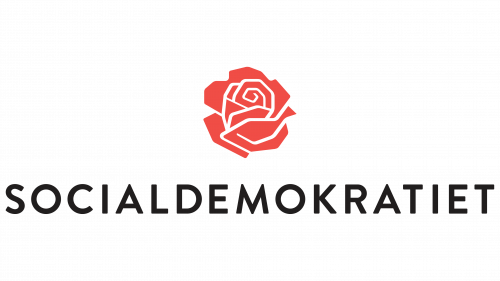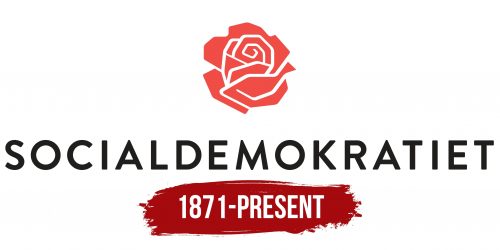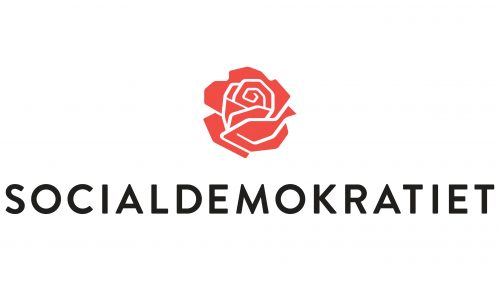The Socialdemokratiet logo conveys the beauty and strength of the fight for freedom and equality. The party strives for peace, the flourishing of society, and every individual. The lines of the emblem reflect the nobility and readiness to uphold these ideals.
Socialdemokratiet: Brand overview
Socialdemokratiet, the Social Democratic Party of Denmark, has a rich history dating back to the late 19th century. It began as the Danish section of the First International, founded on October 15, 1871, by Louis Pio, Harald Brix, and Paul Geleff. This era of rapid industrialization and a growing working class in Denmark provided fertile ground for the rise of socialist ideas.
Initially named “Den Internationale Arbejderforening for Danmark” (The International Workers’ Association for Denmark), the party rebranded in 1876 as the “Social Democratic Federation,” reflecting a commitment to social-democratic ideology. The first significant political achievement came in 1884 when two representatives were elected to the Danish Parliament (Folketing). This milestone began a long journey towards political influence in the country.
In 1896, the organization adopted its first official program, outlining core goals and values, including demands for an eight-hour workday, universal suffrage, and social security for workers. Its influence grew steadily in the early 20th century. In 1924, Thorvald Stauning became Denmark’s first Social Democratic Prime Minister, ushering in a new era in the nation’s history. The period from 1929 to 1940, known as the “Red Cabinet” era under Stauning’s leadership, laid the foundation for Denmark’s welfare state.
After World War II, the Social Democrats continued to play a pivotal role in Danish politics. Vilhelm Buhl led the post-war coalition government from 1945 to 1947, focusing on rebuilding the nation. The period from 1953 to 1968 is often called the “Golden Age” of the Social Democrats. Under leaders like Hans Hedtoft, H.C. Hansen, and Jens Otto Krag, the party implemented significant social reforms that strengthened Denmark’s welfare system.
The leadership of Jens Otto Krag and Anker Jørgensen marked the 1970s. Jørgensen, in particular, led the government from 1975 to 1982, continuing social reforms despite the economic challenges of the time. In 1993, Poul Nyrup Rasmussen became Prime Minister and remained in office until 2000. His tenure was characterized by the “Third Way” approach, blending social-democratic principles with elements of the market economy.
After a period in opposition from 2001 to 2011, the party returned to power under Helle Thorning-Schmidt, who became the first female Social Democratic Prime Minister. Her government (2011-2015) navigated the global economic crisis with policies to maintain the welfare state while implementing austerity measures. Following another period in opposition, Mette Frederiksen led the party to victory in 2019 and became Prime Minister, forming a minority government. Her tenure has focused on climate policy and strengthening social protection.
Meaning and History
What is Socialdemokratiet?
It is a political party in Denmark that adheres to the ideals of social democracy. The party focuses on social justice, equality, solidarity, and democratic socialism. It aims to improve working conditions, provide accessible healthcare and education, and promote social welfare. The Social Democratic Party actively participates in the country’s political life, representing the interests of its voters in parliament and other state institutions.
1871 – today
Including a rose in the party logo is linked to the history of the struggle for social and political rights, starting from the French Revolution. This symbol, adopted by European social democrats, continues to represent the unity and solidarity of the working class. The red color of the rose reminds us of the sacrifices and efforts made in this struggle and the constant drive to create a just society. The emblem reflects a deep connection to the history and traditions of the social democratic movement, emphasizing the party’s readiness to defend its ideals and fight for a bright future.
The Socialdemokratiet logo features an image of a rose. Above the flower, the party name is written in thin, uppercase black letters.
Historically, the rose symbol emerged during the French Revolution. The flower embodied the fight for liberty, equality, and fraternity. Gradually, European social democrats adopted this image to represent the working class’s struggle for their rights and a more equitable society. The rose symbolizes the united movement of the Socialist International and indicates the cooperation of supporters worldwide.
The elegant and beautiful rose emphasizes the aspiration for a just, kind, and honest world where everyone can realize their potential. However, the plant has thorns. This symbol implies struggle, the party’s ability to defend its beliefs, and protect the new world. The red color of the flower underscores the sacrifices made to achieve these ideals.
The party name is written in thin, uppercase black letters at the bottom of the emblem. The light glyphs balance the delicate petals of the rose. The uniform sizes and spacing between the letters highlight the organization’s clear slogans, structured positions, and statutes.
The red color of the rose symbolizes passion, energy, and determination in the fight for rights and freedoms. The black color of the letters represents the party’s strength, stability, and firmness of convictions.





